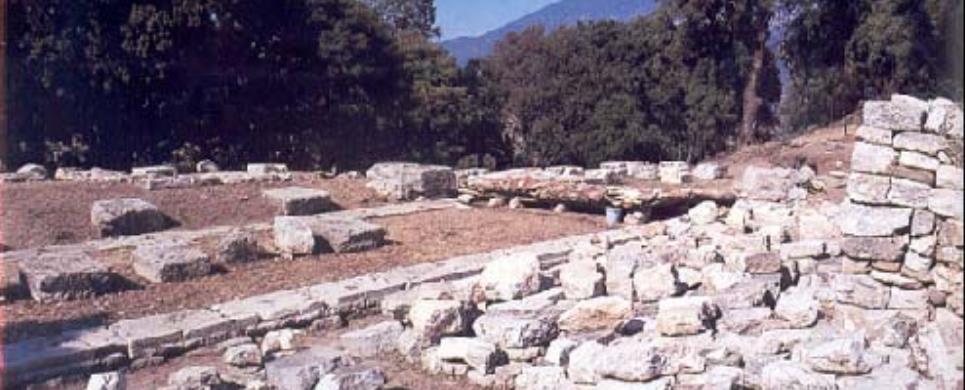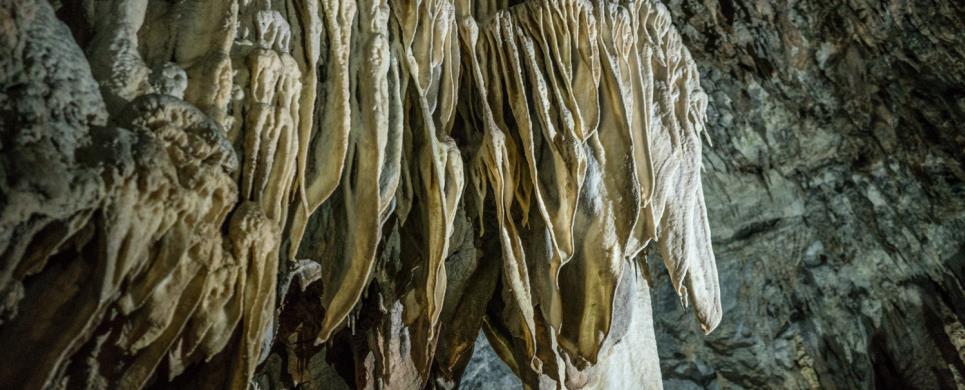Listed 4 sub titles with search on: Archaeological sites for wider area of: "KALAVRYTA Province ACHAIA" .

LOUSSES (Ancient city) KALAVRYTA
Ancient Lousoi (province of Achaia, Peloponnese), is located on the slopes of
the high valley of Sudena near Kalavrita at an alitude of ca. 1200 m. above sea
level, and in antiquity belonged to the region of Arcadia.
After the discovery of the sanctuary of Artemis Hemera in Lousoi by
W. Dorpfeld and A. Wilhelm in 1897, the sister-institute of the Austrian Archaeological
Institute (OAI) in Athens carried out the first excavations in three campaigns
during 1898 and 1899, under the direction of W. Reichel and A. Wilhelm.
In the sanctuary which extended over two terraced areas, the foundations
of numerous structures were nearly completely exposed, structures which exemplify
the necessary infrastructure of a small rural sanctuary of the 3rd century B.C.
The central building of the sanctuary, the temple of Artemis, was located on the
southern terrace, the higher one; its noteworthy groundplan consists of a central
naos and colonnades connected at the sides. Constructions on the slightly lower
northern terrace accompanied the road to the sanctuary, and according to the interpretation
of the excavators included a fountain house, a "propylon" (gateway) and a "bouleuterion"
(council building). The rapid publication of the architectural elements, as well
as the finds, which include votives connected to the cult of Artemis represents
even today the primary focus of research at the sanctuary.
As part of the excavations, which were renewed in 1980 under the direction
of V. Mitsopoulos-Leon and which continue to date, a survey of the architectural
remains of the extensive settlement area visible in the region has been undertaken
(F. Glaser). To this end, systematic field research has concentrated on excavations
in the sanctuary of Artemis and on the uncovering of domestic housing in the region
of Phournoi, as well as on the measurement of the remains of public structures
in the area called "stadion".
In the sanctuary, the finds recovered from undisturbed stratigraphic
layers reveal the early phase of the cult of Artemis. From the analysis of the
broad spectrum of votive gifts such as bronze jewellery, small figural bronzes
and terracottas, lead and bone votives (V. Mitsopoulos-Leon, Ch. Schauer), pyxides
for the cult and miniature vessels (Ch. Schauer), it is clear that, for the late
geometric and archaic periods, this sanctuary played a leading transregional role,
when seen against the back of similar sacral places. The discovery of the so-called
East Building expands the picture of the architectural layout of the temple terrace,
and points to a possible predecessor of the 4th c. B.C. The complete clearing
of the temple foundations and the search for architectural elements enable to
a great extent the reconstruction and classification of this building from the
turn of the 4th-3rd century B.C. or slightly afterwards. The structure, which
consists of a marble architectural order at the front and in the cella, is divided
into a naos, consisting of pronaos, cella and adyton, and into lateral colonnades
at the sides, comprising a unique solution for a sacred building (G. Ladstatter).
With the excavated remains of two houses from the area of Phournoi,
extending over two terraces, the hellenistic domestic culture of Lousoi can be
clarified. Neither the eastern peristyle house, which probably represents an adaptation
of one or more earlier structures, nor the simpler house to the west, embody canonical
groundplans. Furthermore, the room inventories, with their klinai, bath tubs,
and hearths, indicate a relatively elevated standard of living. The troughs for
wine production located near the domestic area, the evidence for the working of
bones and of ceramic production, as well as storage rooms, point to predominantly
agrarian resources as the economic basis of the people of Lousoi. From a rebuilding,
incorporating numerous stretches of walls, which occurred after the houses were
destroyed all at once probably in the 1st cent. A.D., it can be seen that the
area continued to be used until the late Imperial period.
The preliminary results of a survey in the region called "stadion"
point to a monumental public building in this area. The foundations of a two-aisled
stoa, further traces of walls arranged in a rectangular ground plan, as well as
massive worked ashlar blocks suggest that the remains of a hellenistic civic square
should be identified here.
From this research, beginning with the development of the sanctuary
in the late 8th century B.C., followed by a hellenistic civic settlement covering
an extensive built up area and with the outgoing use of the site in the late Roman
period, important stages of the historical development of the settlement of Lousoi
can be recognised.
The foundations of the Artemis sanctuary and the groundplans of the
houses are visible high above the valley in an impressive location. Until the
construction of a museum at the site, the most important finds are kept in the
Ephorate in Patras.
Veronika Mitsopoulos-Leon Feb 2004
This text cited Aug 2004 from the Austrian Archaeological Institute's URL http://www.oeai.at/eng/ausland/lousoi.html
which contains 3 images and bibliography.

KASTRIA (Village) KALAVRYTA
Tel: +30 26920 31633
Fax: +30 26920 31588
In the village Kastria of Achaia,
60km from Tripoli (tunnel
at Artemision) and 9 Km from
Kleitoria, lies the famous
“Cave of the Lakes”.
It is a rare creation of Nature. Apart from its labyrinth of corridors,
its mysterious galleries and its strange stalactite formations, the “Cave
of the Lakes” has something exclusively unique that does not exist in other
well known caves. Inside the cave there is a string of cascading lakes forming
three different levels that establish its uniqueness in the world.
The cave is an old subterranean river whose explored length is 1980
meters. In winter when the snow melts, the cave is transformed into a subterranean
river with natural waterfalls. In the summer months, part of the cave dries up
revealing a lace-work of stone-basins and dams of up to 4 m. in height. The rest
of the cave retains water permanently throughout the year in 13 picturesque lakes.
TOURIST ROUTE
The developed part of the cave is currently 500 meters long. It includes
artistic lighting. The visitor enters the cave through an artificial tunnel which
leads directly to the second floor. The dimensions of this part of the cavern
create awe, rapture, admiration. The passage from lake to lake is possible by
small man-made bridges.
PALEONTOLOGICAL INTEREST
At the cave’s lower floor, human and animal fossils
were found, among which that of a hippopotamus. This part of the cave is intended
to become a biological cave laboratory of international standing.
THE CAVE’S LEGEND
The legend says that the daughters of Proitos, king of Tirynth, Lyssippi,
Ifinoy and Ifianassa, bragged that they were more beautiful than the Goddess Hera
and scorned the worship of the God Dionysus. Zeus’s mate didn’t forgive
their vanity and took their sanity, causing them to believe that they were heifers
running wild on the mountains and meadows of Peloponnisos,
infecting the women of Argolida
with the craze of infanticide. Someday they arrived at the cave of Aroanios
were they were found by Melambodas who cured them. He then led them to the village
Loussoi.
EXPLORATION - DEVELOPMENT OF THE CAVE
In 1965, the residents of the valley of Kastria reached for
the first time the second floor, using wooden ladders from a 9 meter ramp. The
cave was explored by the E.O.S. (Hellenic Alpine Club) with the help of Prof.
I. Melendis and mapped by the E.S.S. (Hellenic Speleological Society) under the
supervision of Mrs. Anna Petrochilou. The development of the cave began in 1981
by E.O.T. (Hellenic
Tourism Organization) and continued from the former community of Kastria. Today
the municipality of
Lefkasio is responsible for the cave’s operation and is resided at Kleitoria
(Mazeika).
LOUSSES (Ancient city) KALAVRYTA
Tel: +30 210 8213708
Fax: +30 210 8220798
Receive our daily Newsletter with all the latest updates on the Greek Travel industry.
Subscribe now!